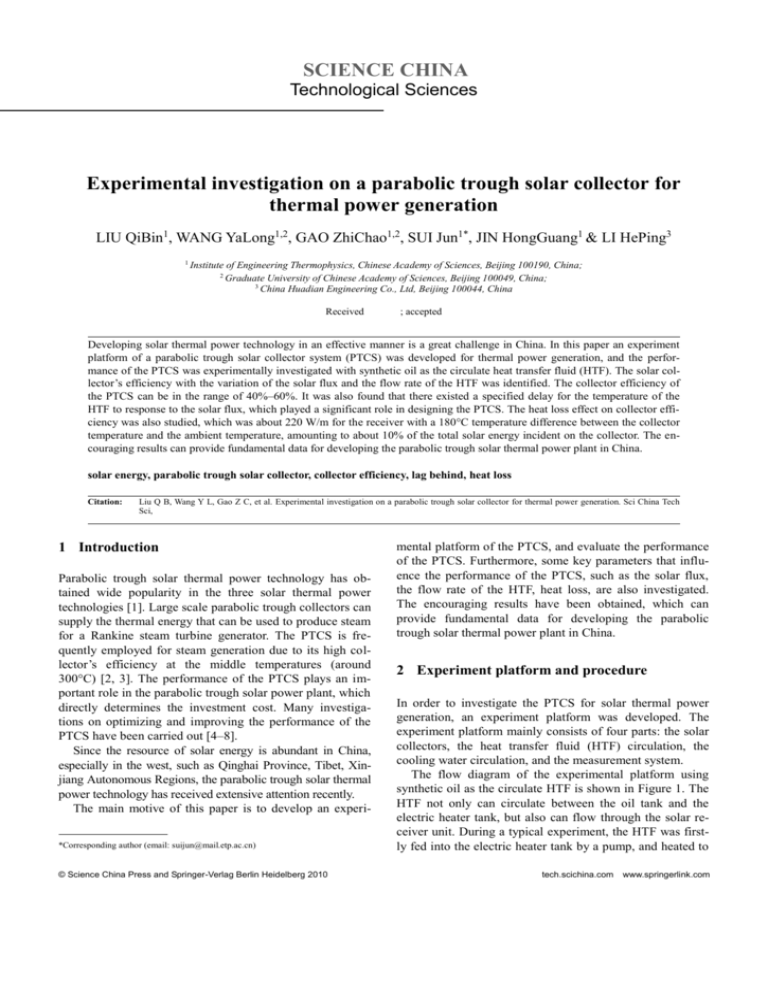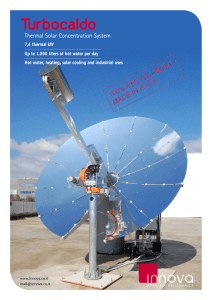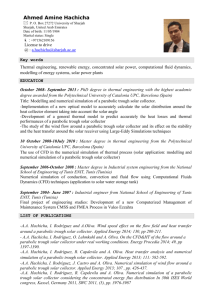LIU QiBin1, WANG YaLong1,2, GAO ZhiChao1,2, SUI Jun1*, JIN
advertisement

SCIENCE CHINA Technological Sciences • ARTICLES • Experimental investigation on a parabolic trough solar collector for thermal power generation LIU QiBin1, WANG YaLong1,2, GAO ZhiChao1,2, SUI Jun1*, JIN HongGuang1 & LI HePing3 1 Institute of Engineering Thermophysics, Chinese Academy of Sciences, Beijing 100190, China; 2 Graduate University of Chinese Academy of Sciences, Beijing 100049, China; 3 China Huadian Engineering Co., Ltd, Beijing 100044, China Received ; accepted Developing solar thermal power technology in an effective manner is a great challenge in China. In this paper an experiment platform of a parabolic trough solar collector system (PTCS) was developed for thermal power generation, and the performance of the PTCS was experimentally investigated with synthetic oil as the circulate heat transfer fluid (HTF). The solar collector’s efficiency with the variation of the solar flux and the flow rate of the HTF was identified. The collector efficiency of the PTCS can be in the range of 40%–60%. It was also found that there existed a specified delay for the temperature of the HTF to response to the solar flux, which played a significant role in designing the PTCS. The heat loss effect on collector efficiency was also studied, which was about 220 W/m for the receiver with a 180°C temperature difference between the collector temperature and the ambient temperature, amounting to about 10% of the total solar energy incident on the collector. The encouraging results can provide fundamental data for developing the parabolic trough solar thermal power plant in China. solar energy, parabolic trough solar collector, collector efficiency, lag behind, heat loss Citation: Liu Q B, Wang Y L, Gao Z C, et al. Experimental investigation on a parabolic trough solar collector for thermal power generation. Sci China Tech Sci, 1 Introduction Parabolic trough solar thermal power technology has obtained wide popularity in the three solar thermal power technologies [1]. Large scale parabolic trough collectors can supply the thermal energy that can be used to produce steam for a Rankine steam turbine generator. The PTCS is frequently employed for steam generation due to its high collector’s efficiency at the middle temperatures (around 300°C) [2, 3]. The performance of the PTCS plays an important role in the parabolic trough solar power plant, which directly determines the investment cost. Many investigations on optimizing and improving the performance of the PTCS have been carried out [4–8]. Since the resource of solar energy is abundant in China, especially in the west, such as Qinghai Province, Tibet, Xinjiang Autonomous Regions, the parabolic trough solar thermal power technology has received extensive attention recently. The main motive of this paper is to develop an experi*Corresponding author (email: suijun@mail.etp.ac.cn) © Science China Press and Springer-Verlag Berlin Heidelberg 2010 mental platform of the PTCS, and evaluate the performance of the PTCS. Furthermore, some key parameters that influence the performance of the PTCS, such as the solar flux, the flow rate of the HTF, heat loss, are also investigated. The encouraging results have been obtained, which can provide fundamental data for developing the parabolic trough solar thermal power plant in China. 2 Experiment platform and procedure In order to investigate the PTCS for solar thermal power generation, an experiment platform was developed. The experiment platform mainly consists of four parts: the solar collectors, the heat transfer fluid (HTF) circulation, the cooling water circulation, and the measurement system. The flow diagram of the experimental platform using synthetic oil as the circulate HTF is shown in Figure 1. The HTF not only can circulate between the oil tank and the electric heater tank, but also can flow through the solar receiver unit. During a typical experiment, the HTF was firstly fed into the electric heater tank by a pump, and heated to tech.scichina.com www.springerlink.com LIU QiBin, et al. a certain temperature. Then the HTF was pumped to the solar receiver unit to absorb the solar energy. The heated HTF leaving the receiver was cooled by the cooling water in a heat exchanger, and finally flowed back to the oil tank, the loop being finished. Considering the coefficient of volume expansion of the HTF at a high temperature, an expansion tank was fixed on the top of the experimental platform. It is worth noting that the energy provided by the electric heater is not considered in the process of evaluating the solar energy. The PTCS with 30 m2 was built in Tongzhou District, Beijing, as shown in Figure 2. Experiments were carried out from nearly 9:00 to 16:00 with different flow rates of the HTF. The main parameters of the PTCS are shown in Table 1. Figure 1 Schematic diagram of the experiment platform. Sci China Tech Sci Rim angle (o) Focal distance (m) Concentration ratio Inner diameter of the receiver (m) Inner diameter of the receiver (m) Inner diameter of glass envelope (m) Outer diameter of glass envelope (m) Mirror reflection coefficient Glass transmission coefficient Absorber absorption coefficient Absorber emissive coefficient Absorber tube conductivity coefficient (W/(m K)) Glass tube conductivity coefficient (W/(m K)) 31 2.25 38 0.0605 0.0635 0.099 0.102 0.90 0.92a) >0.9a) 0.08@100°C 0.20@400°C a) 1.2 40 a) Data from manufacturer’s product information. The single-axis-tracking PTCS was positioned in an east-west direction, and was composed of metal frame, silver-plated glasses mirrors, the collector receiver, and the collector’s position controller. The position of the collector platform could be moved automatically and manually. A diagram of the heat collector element (HCE) is shown in Figure 3. A solar receiver is a stainless steel tube with cermet selective coatings spread on the outside surface. In order to reduce the heat loss, the annulus space between the receiver and the glass envelope keeps the vacuum state. Both the ends of the HCEs are jointed bellows. The temperatures were measured using temperature sensors of PT100 with the accuracy rating ±0.15°C inserted in the solar receiver as shown in Figure 3. The outside wall temperature of the receivers was also measured by temperature sensors of PT100. The direct normal irradiation was measured using a normal incidence pyrheliometer, and its precision can be controlled within 2%. The flow rate of the HTF in the loop was measured using a metal rotermeter, and its precision is in the range of 1%. The wind velocity was measured using the anemometer. All temperature and the direct normal irradiation data were automatically collected by the data acquisition system from Agilent Technologies. The solar thermal energy absorbed by the HTF can be computed by Qeff VC p (T0 Ti ). Figure 2 Photograph of the experiment platform. Table 1 Parameters of the solar PTCS Item Collector aperture area (m2) Collector aperture (m) Length (m) Value 30 2.5 12 (1) The solar collector efficiency can be calculated by c Qeff / IA, (2) where Ti and To stand for the inlet temperature and outlet temperature of the PTCS, respectively; V indicates the oil volume flow rate; represents the density of the HTF; Cp is LIU QiBin, et al. Sci China Tech Sci Figure 3 Schematic of an HCE. the isobaric specific heat capacity; I stands for the solar flux; A is the effective area of the parabolic trough concentrators. The heat loss in the parabolic trough field include the heat loss from the receivers Qr, Qc, and the heat loss through the bellows and supporters Qb. The heat loss from receivers mainly includes two parts, one is the heat loss Qc from the PTCS to the surroundings by convection, the other is the heat loss Qr from the PTCS to the sky by radiation. The heat loss Qc and Qr can be obtained by the followings, respectively. Qc hπ D(Tg Ta ), (3) 4 Qr π D (Tg 4 Tsky ), (4) where is the emissivity of the glass envelope outer surface; h stands for convection heat transfer coefficient; D is outer diameter of the receiver; indicates StefanBoltzmann constant; Tg and Tsky represent the temperature of the outside wall of the receivers and sky. The heat loss Qb through the bellows can be estimated based on the ref. [9]. Detail report on the numerical simulation method for collector performance can be found in our previous work [10]. Correlations for the density , thermal conductivity , isobaric specific heat capacity Cp and dynamic viscosity of the HTF named YD-300 can be described as follows: = 2.5714 104T 2 8.9333 101T 1.2438 103 (kg/m3); = 7.471410 8T 2 1.333810 4 T 1.558010 1 (W/(m K)); C p = 1.1954 10 3 T 2 4.6099T 5.1196 102 (kJ/(kg K)); = 9.7755 10 8T 4 1.9000 10 4T 3 1.3815 10 1T 2 4.4610 101 T 5.4188 10 3 (Pa s). 3 Results and discussion Many important factors, such as the solar flux, the flow rate of the HTF and the heat loss, influence the performance of the PTCS for thermal power generation. Therefore, they are taken into account in this study as follows. A typical result obtained in September 21, 2009 is shown in Table 2, in which the volume flow rate of the HTF is 0.45 m3/s. Ta, Ti, To and c stand for the ambient temperature, the inlet temperature of HTF, outlet temperature of the HTF and collector efficiency, respectively. Figure 4 shows the relationship between the efficiency of the PTCS and the solar flux under different volume flow rates. The simulation result has been also obtained considering the solar flux varying from 200 to 900 W/m2 in accordance with the experimental condition. The flow rates of the HTF were fixed at 0.45 m3/h, 0.28 m3/h and 0.10 m3/h, respectively. From Figure 4, it can be found that the collector efficiency was in a range of 40%–60%. The experimental data scattered the simulation line. Analyzing Figure 4, it LIU QiBin, et al. Table 2 Time 12:00 12:15 12:30 12:45 13:00 13:15 13:30 13:45 14:00 14:15 14:30 Experiment data at a flow rate of 0.45 m3/h Ta 25.8 25.2 28.0 28.0 29.3 30.8 31.2 30.0 30.0 29.8 31.7 Ti (°C) 94.5 107.1 124.7 131.5 135.5 135.5 129.9 134.8 137.9 139.2 138.9 To(°C) 151.1 166.0 169.0 163.2 163.7 154.4 163.0 165.0 167.3 165.7 159.3 2 I (W/m ) 825 813 789 770 730 704 649 610 567 530 466 c 0.570 0.611 0.577 0.550 0.530 0.527 0.535 0.523 0.542 0.527 0.492 Sci China Tech Sci sponse lagged behind the decrease of the solar flux. When the solar flux is variable, identifying the time interval of the temperature lag is essential. The simplest case available for verifying the influence of the heat capacity is the case with no-sun on the absorber, as shown in Figure 6. The experiment was done from 14:50 to 16:00 in the afternoon, and the flow rate of the HTF was 0.40 m3/h. It can be seen that the temperature difference between the outlet and inlet of the HTF still kept positive and became smaller with the time. This was because that the energy absorbed by the HTF was from the PTCS, such as receivers, bellows and supports. 15 min later, nearly at 15:05, the inlet and outlet temperatures tended to the same. This characteristic plays an important role in the design and operation of the parabolic trough solar power plants. The similar property was also reported by Senthilkumar et al. [11]. The thermal output of the PTCS depends on the energy that the absorbed solar radiation incident on the collector reduced the losses of the collector, including the heat loss, optical loss. So it is a key issue how to determine the heat loss. If the outside wall temperatures of the receivers are obtained, the heat loss in the parabolic trough field from the receivers Qr can be easily calculated approximately for a known wind speed and ambient temperature. The method Figure 4 The variation of collector efficiency with solar flux. can be found that the collector efficiency nonlinearly depends on the solar flux. When HTF flow rate was 0.45 m3/h, the efficiency had an increase of 7% from 200 to 550 W/m2, while only 3% from 550 to 900 W/m2, and the maximum of collector efficiency could be obtained at the highest solar flux within the study range. A reason is that the mean temperature of the receiver increased drastically for these values, the heat gained by the HTF went up slowly due to the heat loss. It can be also seen from Figure 4 that the collector efficiency was very low at the flow rate of 0.10 m3/h. Since the Reynolds number is below 1000, and the heat transfer between the receiver and the HTF becomes seriously worsened. Figure 5 shows the relationship between the collector efficiency and the solar flux from morning to afternoon. The experiment was carried out from 10:30 to 14:30, June 3, 2009. It was found that the collector efficiency in the afternoon was higher than in the morning. A possible reason is the heat capacity of the main structure of the PTCS, such as the metal brackets, bellows temperatures, were very low in the morning, and a larger percent of the solar thermal energy was absorbed by the body of the PTCS. With the decrease of the solar flux, the temperature of the HTF would not fall immediately due to high temperature of the main body structure of the PTCS. Therefore, the temperature re- Figure 5 flux. Variation of collector efficiency with solar LIU QiBin, et al. Figure 6 Variations of temperature of the HTF and heat absorbed by the HTF without sun. Figure 7 Heat loss versus the fluid temperature above ambient. cannot depend on the receiver condition, such as vacuum, air, lost vacuum. In this paper, temperature sensors of PT100 were surrounded the receivers, and aluminum foils were used to prevent the temperature sensors from directly absorbing the normal irradiation. The similar measure method was performed by Liipfert et al. [12], who used an infrared camera to evaluate the in-situ thermal performance of parabolic trough receivers. Figure 7 shows the heat loss and temperature difference of the HTF temperature above the ambient temperature with time. The experiment was done under the condition of the velocity of about 2 m/s and the ambient temperature in the range of 29.5–31.5°C. It can be found that the HTF temperature above the ambient temperature decreased with the time. It is mainly because the solar irradiation incident on the collector goes down with the time. It is noteworthy that the HTF temperature above the ambient temperature has a small decrease from 13:30 to 13:50. A possible reason is the effect of the shading of the collector supports and a little increase of solar irradiation. As also seen from Figure 7, the heat loss by convection and radiation both decreased with the time, and the heat loss were about 220 W/m for the PTCS for a 180°C temperature difference between the collector temperature and the ambient temperature, which could amount to about 10% of the total solar energy incident on the collector. 4 Conclusion In this paper an experiment platform of a parabolic trough solar collector system (PTCS) was developed for thermal power generation, and the performance of the parabolic trough solar collector was experimentally investigated with Sci China Tech Sci synthetic oil as the circulate heat transfer fluid (HTF). The collector efficiency of the PTCS can be obtained in the range of 40%–60%. It was also found that there exists a specified delay between the temperature response of the HTF and the solar flux, which played a significant role in designing the PTCS. The heat loss effect on collector efficiency was also studied, which was about 220 W/m for the receiver at a 180°C temperature difference between the collector temperature and the ambient temperature, amounting to about 10% of the total solar energy incident on the collector. The encouraging results can provide fundamental data for developing the parabolic trough solar thermal power plant in China. This work was supported by the National Natural Science Foundation of China (Grant No. ……) and the National Basic Research Program of China (“973” Program) (Grant No. ……). 1 2 3 4 5 6 7 8 9 10 11 12 Price H, Lupfert E, Kearney D, et al. Advances in parabolic trough solar technology. J Sol Energ-T ASME, 2002, 124(2): 109–125 Kalogirou S, Lloyd S, Ward J. Modeling, optimization and performance evaluation of a parabolic trough solar collector steam generation system. Sol Energy, 1997, 60(1): 49–59 Bakos G C, Ioannidis I, Tsagas N F, et al. Design, optimization and conversion-efficiency determination of a line-focus parabolic-trough solar-collector (PTC). Appl Energ, 2001, 68(1): 43–50 Dudley V, Kolb G, Sloan M. Test Results: SEGS LS2 Solar Collector. Report of Sandia National Laboratories, SANDIA 94-1884. 1994 Quaschning V, Kistner R, Ortmanns W. Influence of direct normal irradiance variation on the optimal parabolic trough field size: A problem solved with technical and economical simulations. J Sol Energ-T ASME, 2002, 124(2): 160–164 Liipfert E, Pottler K, Ulmer S, et al. Parabolic trough optical performance analysis techniques. J Sol Energ-T ASME, 2007, 147(2): 147–152 Yang Y P, Cui Y H, Hou H J, et al. Research on solar aided coal-fired power generation system and performance analysis. Sci China Tech Sci, 2008, 51(8): 1211–1221 Jin H G, Hong H, Sui J, et al. Fundamental study of novel mid-and low-temperature solar thermochemical energy conversion. Sci China Tech Sci. 2009, 52(5): 1135–1152 Odeh S D, Morrison G L, Behnia M. Modeling of parabolic trough direct steam generation solar collectors. Sol Energy, 1998, 62(6): 395–406 Gao Z C, Sui J, Liu Q B, et al. Modeling and analysis of 30 m2 parabolic trough collector (in Chinese). In: Chinese Society of Engineering Thermophysics Conference. Beijing: Chinese Society of Engineering Thermophysics, 2009 Senthilkumar S, Perumal K, Srinivasan P S S. Optical and thermal performance of a three-dimensional compound parabolic concentrator for spherical absorber. Sadhana-Acad P Eng S, 2009, 34(3): 369–380 Liipfert E, Riffelmann K J, Price H. Experimental analysis of overall thermal properties of parabolic trough receivers. J Sol Energ-T ASME, 2008, 130(2): 021007





